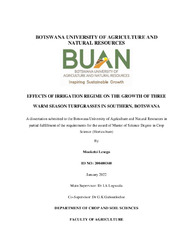| dc.description.abstract | Botswana is known for its unreliable rainfall, extended dry spells and heat. The combination of these factors puts great demand on water conservation strategies in turfgrass management. These strategies dictate that turfgrasses should be managed increasingly under less frequent or deficit irrigation, yet limited research has been carried out to evaluate growth of warm season turfgrasses as influenced by irrigation regimes in Botswana. A field study was conducted at the Botswana University of Agriculture and Natural Resources (BUAN) from May 2018 to September 2018 to evaluate the effect of irrigation regimes on the growth of three warm season turfgrasses in southern Botswana. The experiment was a factorial arranged as a randomized complete block design (RCBD) with two factors: irrigation regimes (four levels) and turfgrass species (three turfgrass species) replicated three times. Four daily irrigation levels were applied as follows; 50%, 75%, 100 % (control) and 110% replacement irrigation of the previous day’s net evaporation measured using a class ‘A’ evaporation pan (Epan). The results showed an increase in root length, root biomass and clip biomass when the three grasses were irrigated at 50% and 75% replacement of daily Epan. Irrigating at 100% (control) and 110% of Epan replacement resulted in shorter root length, lower root biomass and clip biomass. All evaluated turfgrasses performed well, when irrigated at 75% of Epan replacement in terms of growth and quality. Regression analysis revealed that ETo contributed 86.3 %, 63.26 % and 88.26 % to variability in root biomass, root length and clip biomass respectively. Higher clip biomass was associated with higher root length and root biomass. vii Based on their performance Cynodon dactylon is the best turfgrass to grow in Botswana followed by Pennisetum clandestine and Buchloe dactyloides, recommended according to their ability to maintain acceptable growth and quality under deficit irrigation. | en_US |

